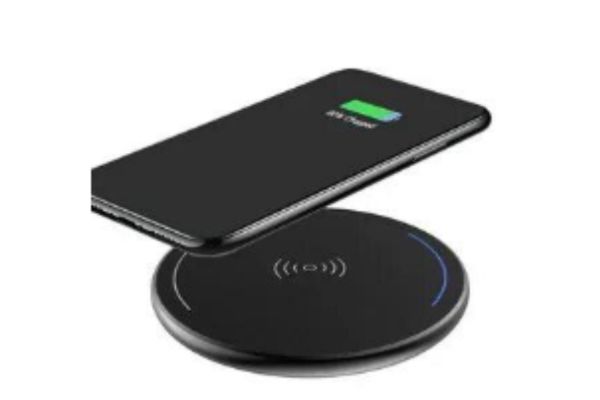In today’s fast-paced world, technology is evolving at an unprecedented rate, and the way we charge our devices is no exception. Traditional wired chargers are quickly becoming a thing of the past as wireless chargers rise in popularity. These innovative devices offer a seamless, convenient, and efficient way to power up smartphones, laptops, and other electronics without the hassle of tangled cables. This article explores the growing significance of wireless chargers, their applications, market trends, and the exciting future of wireless charging technology.
The global wireless chargers market is forecast to reach US$ 14.5 billion by 2025, growing at a robust CAGR of 23.5% to reach US$ 63.8 billion by 2032. The surge in demand is driven by the shift toward more efficient, cable-free charging solutions, particularly in electric vehicles (EVs), smartphones, and wearables. Government initiatives supporting EV infrastructure and advancements in wireless charging technology are key growth drivers. Notable innovations, such as inductive charging coils on roads for EVs, demonstrate the potential for seamless, on-the-go charging. Despite challenges like slower charging speeds, the market is poised for growth as companies work toward faster, more efficient wireless solutions. The automotive sector, in particular, is seeing significant adoption, with wireless charging systems becoming an essential feature in EVs, enhancing convenience and reducing range anxiety.
What Are Wireless Chargers?
Wireless chargers are devices that allow you to charge your electronics without the need for physical connectors. Using technologies like inductive charging or resonant inductive coupling, wireless chargers transfer energy to the battery of your device through electromagnetic fields. This means that instead of plugging in a charging cable, users can simply place their devices on a charging pad, which is connected to a power source.
Although wireless charging was once considered a futuristic concept, it has now become a mainstream technology. Today, most smartphones, smartwatches, and wireless earbuds come equipped with wireless charging capabilities. The technology is also being incorporated into various consumer electronics, from laptops to kitchen appliances.
How Wireless Charging Works: The Technology Behind It
Wireless charging relies on a combination of two key components: a transmitter and a receiver. The transmitter is typically built into the charging pad or station, while the receiver is integrated into the device that needs charging, such as a smartphone or tablet.
The process begins when the transmitter sends an electromagnetic field, which induces a current in the receiver coil. This current is then converted into DC (direct current) energy, which charges the device’s battery. Inductive charging and resonant inductive coupling are the two primary methods for wireless charging.
Inductive charging is the most common technology used in wireless chargers, where the coils in the transmitter and receiver create a magnetic field. Resonant inductive coupling, on the other hand, allows the transmitter and receiver to be placed further apart, offering greater flexibility in terms of charging distance.
Advantages of Wireless Chargers
The shift toward wireless charging has been largely driven by the many advantages this technology offers over traditional wired charging. Here are some of the key benefits of wireless chargers:
- Convenience and Ease of Use: Wireless chargers eliminate the need for cords and cables. Simply place your device on the charging pad, and the charging process begins. This offers a more user-friendly experience, especially in the fast-paced, on-the-go lifestyle of modern consumers.
- Reduced Wear and Tear: Over time, frequent plugging and unplugging of charging cables can damage both the cable and the device’s charging port. Wireless charging helps avoid this issue, increasing the longevity of devices and accessories.
- Cleaner and Tidy Setup: With wireless charging, there are fewer cables cluttering your workspace or home. This is especially beneficial in modern homes and offices where a minimalist aesthetic is preferred.
- Multi-Device Charging: Many wireless charging pads support multiple devices at once, making it easy to charge your smartphone, smartwatch, and wireless earbuds simultaneously, all without needing separate cables for each.
- Increased Safety: Wireless chargers are generally safer to use, as they reduce the risk of electrical shocks or short-circuiting that could occur from plugging in damaged wires.
Market Trends and Growth
The wireless charger market has witnessed significant growth in recent years, driven by increasing consumer demand for convenience, the rise of smartphones with wireless charging capabilities, and advancements in charging technologies. According to market research, the global wireless charging market is expected to reach USD 22.2 billion by 2027, growing at a CAGR of 25.3% from 2020 to 2027.
The expansion of wireless charging technology is not limited to smartphones. In fact, many industries are exploring its potential, including automotive, healthcare, and home appliances. For example, electric vehicle (EV) manufacturers are looking at wireless charging as a solution for making the charging process more seamless and eliminating the need for plug-in charging stations.
Additionally, wireless chargers are becoming increasingly affordable and accessible, with more budget-friendly options available for consumers. Major companies such as Apple, Samsung, and Xiaomi are all investing heavily in wireless charging technology, further driving the market’s growth.
The Role of Wireless Charging in the Automotive Industry
One of the most exciting areas where wireless chargers are making an impact is in the automotive industry. Wireless charging technology is being integrated into electric vehicles (EVs) to simplify the charging process. Rather than relying on plugging cables into the vehicle, wireless charging stations would enable EVs to charge by simply parking over a charging pad.
This technology would make EV ownership more convenient, particularly in urban environments where public charging stations may be limited or difficult to access. It also provides a more eco-friendly alternative by reducing the need for excessive cables, which can be environmentally harmful.
Several companies are already testing and developing wireless charging systems for electric vehicles, and it’s expected that these systems will become more widely available in the coming years.
Challenges and Limitations of Wireless Chargers
While wireless charging offers many benefits, it does come with its own set of challenges and limitations. Some of the most significant issues include:
- Efficiency: Wireless charging is typically slower compared to wired charging. The energy transfer between the transmitter and receiver is less efficient, meaning that it can take longer to fully charge a device.
- Limited Range: Most wireless chargers require the device to be placed directly on the charging pad or within close proximity. This restricts the freedom of movement compared to traditional charging methods.
- Compatibility: Not all devices are compatible with wireless charging, as they need to have a built-in receiver. Although many modern devices support wireless charging, older models may not.
- Heat Generation: Wireless charging can generate heat, which may affect the longevity of the device’s battery. Manufacturers are continuously working to improve the heat dissipation in wireless charging devices to mitigate this issue.
- Cost: Although prices for wireless chargers have decreased over time, high-quality chargers with advanced features can still be relatively expensive compared to traditional wired chargers.
The Future of Wireless Chargers
The future of wireless charging looks promising, with new innovations and improvements on the horizon. As charging speeds increase and new technologies, such as long-range wireless charging, are developed, the limitations of current wireless charging solutions will gradually be overcome.
In addition, the integration of wireless charging in more consumer electronics, such as laptops, wearable devices, and home appliances, will further enhance its convenience and appeal. The automotive industry’s adoption of wireless charging for electric vehicles is also expected to play a major role in the widespread use of this technology.
As wireless charging continues to evolve, it has the potential to become the standard for charging devices across various industries, making it a game-changer for the tech world.
Conclusion: Embracing the Wireless Charging Revolution
Wireless charging is no longer a novelty but a crucial part of the tech ecosystem. As it continues to evolve, its advantages in terms of convenience, safety, and versatility make it a powerful tool for powering up devices. From smartphones to electric vehicles, wireless chargers are setting the stage for a future where cables are no longer necessary.
With the growing demand for seamless, efficient technology, the wireless charging market is set to expand rapidly in the coming years. Consumers can expect faster, more efficient wireless charging solutions, while industries from automotive to healthcare explore the potential of this game-changing technology.

















